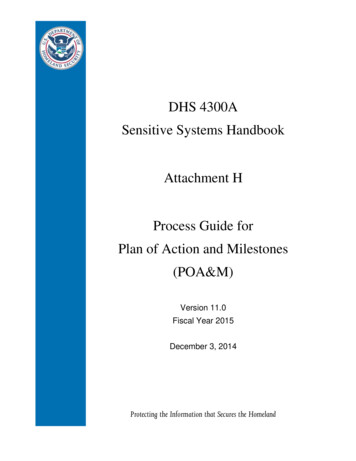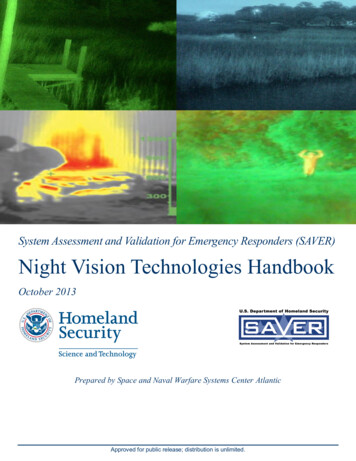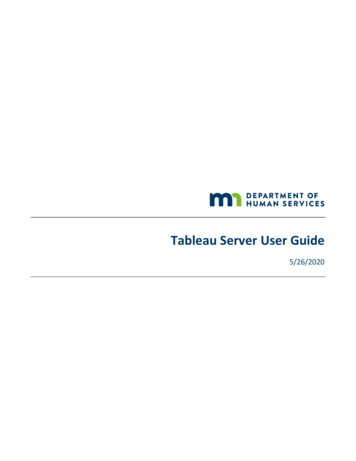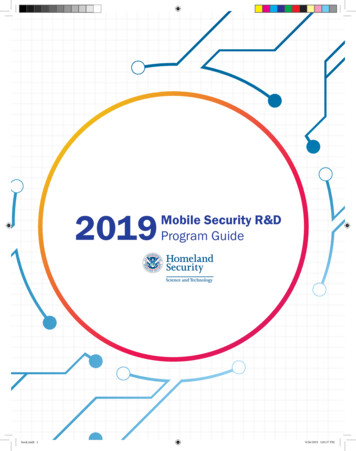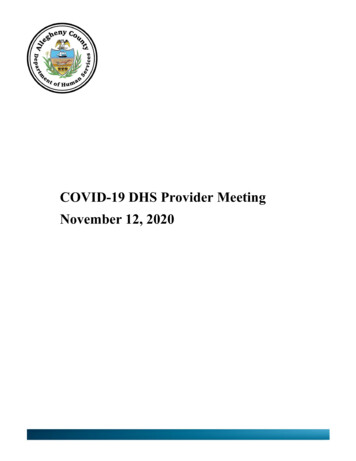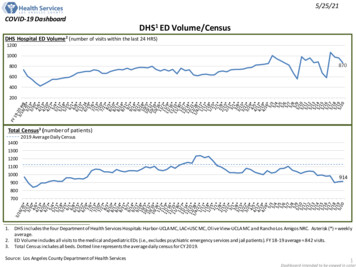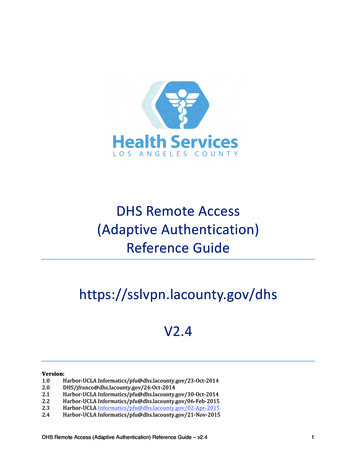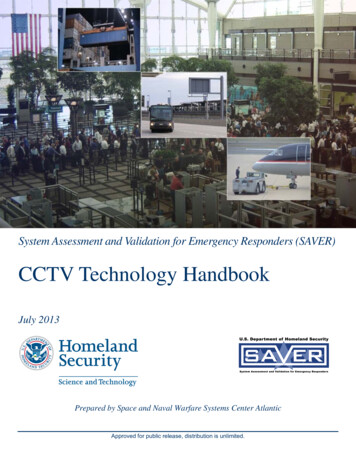
Transcription
System Assessment and Validation for Emergency Responders (SAVER)CCTV Technology HandbookJuly 2013Prepared by Space and Naval Warfare Systems Center AtlanticApproved for public release, distribution is unlimited.
The CCTV Technology Handbook was funded under Interagency Agreement No.HSHQDC-07-X-00467 from the U.S. Department of Homeland Security, Science andTechnology Directorate.The views and opinions of authors expressed herein do not necessarily reflect those of theU.S. Government.Reference herein to any specific commercial products, processes, or services by trade name,trademark, manufacturer, or otherwise does not necessarily constitute or imply itsendorsement, recommendation, or favoring by the U.S. Government.The information and statements contained herein shall not be used for the purposes ofadvertising, nor to imply the endorsement or recommendation of the U.S. Government.With respect to documentation contained herein, neither the U.S. Government nor any of itsemployees make any warranty, express or implied, including but not limited to the warrantiesof merchantability and fitness for a particular purpose. Further, neither the U.S. Governmentnor any of its employees assume any legal liability or responsibility for the accuracy,completeness, or usefulness of any information, apparatus, product or process disclosed; nordo they represent that its use would not infringe privately owned rights.Approved for public release, distribution is unlimited.
FOREWORDThe U.S. Department of Homeland Security (DHS) established the System Assessment andValidation for Emergency Responders (SAVER) Program to assist emergency respondersmaking procurement decisions. Located within the Science and Technology Directorate (S&T)of DHS, the SAVER Program conducts objective assessments and validations on commercialequipment and systems and provides those results along with other relevant equipmentinformation to the emergency response community in an operationally useful form. SAVERprovides information on equipment that falls within the categories listed in the DHS AuthorizedEquipment List (AEL). The SAVER Program mission includes: Conducting impartial, practitioner-relevant, operationally oriented assessments andvalidations of emergency responder equipment; and Providing information, in the form of knowledge products, that enablesdecision-makers and responders to better select, procure, use, and maintain emergencyresponder equipment.Information provided by the SAVER Program will be shared nationally with the respondercommunity, providing a life- and cost-saving asset to DHS, as well as to Federal, state, and localresponders.The SAVER Program is supported by a network of Technical Agents who perform assessmentand validation activities. Further, SAVER focuses primarily on two main questions for theemergency responder community: “What equipment is available?” and “How does it perform?”As a SAVER Program Technical Agent, the Space and Naval Warfare Systems Center(SPAWARSYSCEN) Atlantic has been tasked to provide expertise and analysis on key subjectareas, including communications, sensors, security, weapon detection, and surveillance, amongothers. In support of this tasking, SPAWARSYSCEN Atlantic prepared the CCTV TechnologyHandbook. CCTV Technologies fall under AEL reference number 14SW-01-VIDA: Systems,Video Assessment, Security.Visit the SAVER section of the DHS S&T website for more information on the SAVERProgram or to view additional reports on CCTV or other technologies.i
POINTS OF CONTACTNational Urban Security Technology LaboratoryU.S. Department of Homeland SecurityScience and Technology Directorate201 Varick StreetNew York, NY 10014E-mail the National Security Technology LaboratoryNational Urban Security Technology Laboratory SAVER WebsiteSpace and Naval Warfare Systems Center AtlanticAdvanced Technology and Assessments BranchP.O. Box 190022North Charleston, SC 29419-9022E-mail the Advanced Technology Assessments Branchii
TABLE OF CONTENTSForeword . iPoints of Contact . iiPreface. vi1. Introduction . 12. CCTV System Design . 12.1Defining System Requirements . 12.2CCTV System Design Considerations . 33. Components of CCTV Systems . 93.1Cameras. 93.2Lenses . 153.3Housing and Mounts . 223.4Video Monitors . 253.5Switchers and Multiplexers. 303.6Video Recorders. 324. Transmission . 364.1Wired Transmission . 364.2Wireless Transmission . 394.3IP Network Transmission . 425. Video Storage. 445.1Media Storage . 445.2Scalable Network Storage . 456. Video Analytics . 467. System Integration . 467.1Systems Approach . 477.2Integrating CCTV Components . 477.3Other Considerations . 488. Emerging Technology. 498.1Digital Technologies . 498.2Improvements to Existing Technology . 508.3Major IT Trends . 509. Vendor Selection Considerations . 50iii
9.1Selection Criteria . 509.2Vendor Resources . 51Appendix A.Glossary. A-1LIST OF TABLESTable 2-1. CCTV System Design Worksheet . 7Table 2-2. Sample Site Survey Checklist . 8Table 3-1. Standard Lenses for Image Sensor Size . 17Table 3-2. Calculating the Horizontal and Vertical FOV . 18Table 3-3. CCTV Monitor Technology Comparisons . 27Table 3-4. Video Transmission Signal Display Types . 28Table 3-5. Rear-Projection Monitor Comparisons. 29LIST OF FIGURESFigure 3-1. CCTV Component Diagram Example . 9Figure 3-2. Color Reference Chart . 12Figure 3-3. Image from Thermal Camera . 12Figure 3-4. Representative CCTV Lens . 15Figure 3-5. Calculating FOV . 17Figure 3-6. Focus Chart Example . 19Figure 3-7. Distortion Comparison . 20Figure 3-8. Approximately 500 Lines of Horizontal Resolution . 20Figure 3-9. Sealed Camera Housing . 23Figure 3-10. Impact-Resistant Housing . 23Figure 3-11. Tamper-Resistant Housing . 23Figure 3-12. Bullet-Resistant Housing . 23Figure 3-13. Camera on Pan-Tilt Head with a Pole Mount . 25Figure 3-14. CRT Monitor . 26Figure 3-15. LED Tiles . 30Figure 3-16. Microprocessor-Based Switcher . 31Figure 3-17. Monitoring Station with Matrix Switcher . 31iv
Figure 3-18. Multiplexers . 32Figure 3-19. Hard Drive Recorder for 19-inch Rack . 35Figure 4-1. Coaxial Cable Construction . 37Figure 4-2. Telephone Network Example. 38Figure 4-3. Types of Antennas for RF Transmission . 41Figure 4-4. Typical Microwave Installation . 42Figure 4-5. IP-Based CCTV System . 42Figure 5-1. Storage Area Network . 45Figure 5-2. Network Attached Storage . 46Figure 7-1. Integrated Security System . 47v
CCTV Technology HandbookPREFACEPURPOSEThis CCTV Technology Handbook provides emergency responders, law enforcement securitymanagers, and other security specialists with a reference to aid in planning, designing, andpurchasing a CCTV system. This handbook includes a description of the capabilities andlimitations of CCTV components used in security applications.SCOPEThe CCTV technologies described in this handbook include cameras, lenses, monitors,multiplexers, recorders, transmission systems, and Internet protocol (IP)-based systems. Thishandbook also provides considerations for implementing a CCTV system. An overview of videoanalytics and programmatic considerations such as design, data storage and retention, cybersecurity strategies, and system integration is also included. The outlook for new or improvedCCTV capabilities is briefly discussed. Information provided in this handbook was gatheredfrom Internet research and consultations with subject matter experts. No assertion is made thatthis handbook is comprehensive in its breadth or depth. It is introductory-level information andshould not be considered a definitive reference for planning or implementing a CCTV system.Such efforts
systems are often used to support comprehensive security systems by incorporating video coverage and security alarms for barriers, intrusion detection, and access control. For example, a CCTV system can provide the means to assess an alarm generated by an intrusion detection system and record the event. A CCTV system links a camera to a video monitor using a direct transmission system. This .

